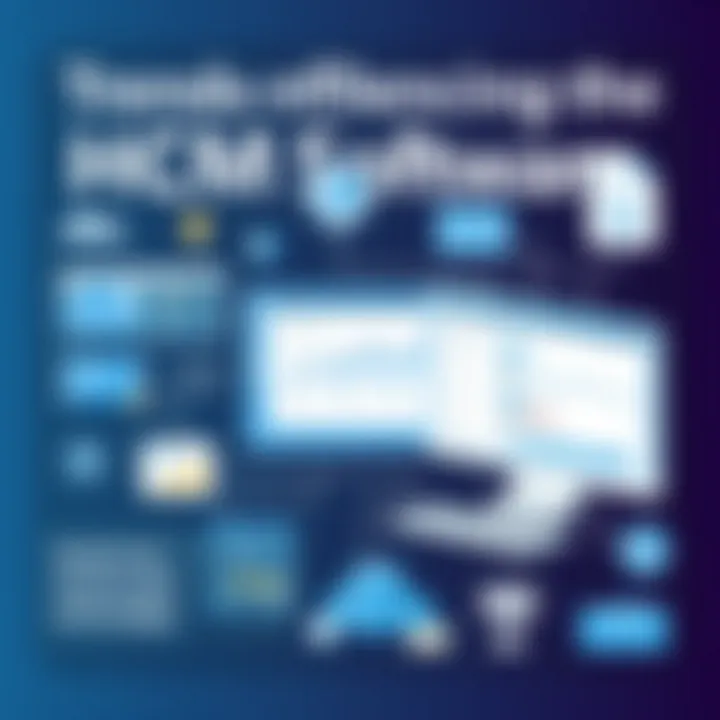Exploring the Landscape of HCM Software Solutions


Intro
In today’s fast-paced corporate landscape, managing talent effectively has become more crucial than ever. Human Capital Management (HCM) software has emerged as a powerful tool for organizations of all sizes, whether a startup or a Fortune 500 giant. It not only streamlines HR processes but also enhances employee engagement and boosts productivity. However, finding the right HCM software can be as tricky as navigating a maze without a map.
The current market is inundated with options, each claiming to be the best. The intricacies of HCM software—ranging from recruitment to performance management—can leave even seasoned professionals scratching their heads. This article aims to demystify the world of HCM software companies, shedding light on their offerings, advancements in technology, and their profound impact on the marketplace.
We will also explore the core features that set apart quality solutions from the rest, delving into what trends are defining the industry today. Further, you’ll find helpful insights for the often-daunting task of selecting suitable software for your organization.
By the time you wrap up this comprehensive guide, you’ll have a firm grasp on HCM software that can not only enhance workplace productivity but also significantly improve employee satisfaction. So, let’s roll up our sleeves and dive in!
Software Overview
Software Description
HCM software consolidates various HR functions into a single, cohesive platform that allows businesses to manage their human resources effectively. From payroll and benefits administration to talent management and analytics, these systems cover the spectrum of HR needs. For instance, companies like Workday and Oracle HCM Cloud provide a comprehensive suite of tools designed to cater to all aspects of an employee's lifecycle within an organization.
The beauty of HCM software lies in its versatility. It can adapt to the size and specific needs of any organization. Whether you are grappling with recruitment, onboarding, or performance evaluations, HCM software offers tailored solutions that can scale with your business.
Key Features
In an overwhelming sea of options, certain features stand out as game-changers:
- Integration Capabilities: Seamlessly connecting with existing software systems can save time and reduce headaches.
- Data Analytics: Real-time reporting and insights help HR teams make better decisions based on employee performance and trends.
- Self-Service Portals: These empower employees to manage their information, request time off, and access benefits, reducing administrative burden on HR staff.
- Mobile Access: Ensuring that employees can access necessary resources from their mobile devices has become crucial, especially in a remote work environment.
By incorporating these features, organizations can not only improve HR efficiency but also create a more satisfying experience for employees.
User Experience
User Interface and Design
The user interface of an HCM software is more than just aesthetics; it plays a vital role in user adoption. A well-designed interface can ease the learning curve and enhance usability. While some platforms may look visually stunning, it's essential that the design prioritizes functionality.
Many HCM solutions offer intuitive dashboards that provide quick access to essential features—think of these as your GPS for navigating through HR tasks. The adaptability of the interface across devices ensures that users can interact effortlessly, whether they are at a desk or on the move.
Performance and Reliability
Performance metrics significantly determine the effectiveness of HCM software. A reliable system ensures that operations run smoothly without downtime interruptions. After all, no company wants their payroll process to hit a snag on payday.
Choosing platforms known for their reliability can make a world of difference. Companies like SAP SuccessFactors and ADP are often highlighted for their robust performance. Robust reporting tools and reliable customer support are also vital for troubleshooting and maintaining workflow efficiency.
In summary, the selection of HCM software is about more than just sifting through features and prices. It’s about finding a partner that aligns with the future vision of your human resources strategy.
As we continue through the article, we will explore the emerging trends in HCM technology and how they are poised to shape the future of human resources management.
Understanding HCM Software
In the modern business landscape, the role of Human Capital Management (HCM) software is becoming increasingly vital. These tools not only streamline HR functions but also play an integral part in enhancing overall organizational performance. By understanding HCM software, businesses can take significant steps toward optimizing their workforce management. This article dives into defining what HCM software is, identifying its key features, and illustrating its differences from traditional HRM software. Such knowledge is essential for IT professionals, software developers, and businesses looking to leverage technology for greater operational efficiency.
Definition and Purpose
Human Capital Management software is designed to assist organizations in managing their most valuable asset: their workforce. Fundamentally, HCM encompasses a range of comprehensive functionalities, from talent acquisition to performance management and employee retention.
To put it simply, HCM software helps automate HR processes, providing a centralized platform where employee data can be stored, managed, and disseminated. This not only improves the efficiency of HR teams but also enhances data accuracy and accessibility. For example, by utilizing an HCM system, a company can reduce the time spent on processing payroll or tracking employee hours quite significantly.
Moreover, the purpose of HCM software extends beyond mere administrative efficiency. It aims to nurture talent, promote employee engagement, and ultimately drive organizational growth. By leveraging analytics within these platforms, managers can make informed decisions related to workforce development—whether that involves nurturing existing talent or identifying areas for new recruitment.
Key Features
When exploring HCM software, several key features distinguish top players in the field:
- Talent Acquisition: Automates the recruitment process, from job postings to candidate screening. This feature can drastically reduce the average time to hire.
- Onboarding: Simplifies the process of integrating new employees into the organization. An effective onboarding system ensures that new hires feel welcomed and informed, ultimately leading to quicker productivity.
- Performance Management: Involves real-time tracking of employee performance, allowing organizations to align individual goals with overall business objectives. This creates a culture of continuous feedback and improvement.
- Learning and Development: Provides tools for employee training and career development, ensuring that the workforce remains competitive and engaged.
- Analytics and Reporting: Offers insights into workforce metrics, aiding data-driven decision-making. Organizations armed with accurate data can better forecast needs and trends.
Such features not only illustrate the capabilities of HCM software but also underscore its role in fostering a proactive approach to human resource management.
Difference Between HCM and HRM Software
At first glance, Human Resource Management (HRM) software and Human Capital Management software may appear similar. However, the distinction lies in their scope and functionality.
HRM software primarily focuses on administrative tasks such as payroll processing, personnel record keeping, and compliance tracking. It serves as a foundational tool for managing employee data but often lacks advanced features for talent development.
On the other hand, HCM software expands its reach into areas that enhance workforce productivity and development. While it includes traditional HR functions, it also emphasizes employee engagement, training, and strategic planning. Essentially, HCM takes a holistic view of employee management, integrating various facets of workforce development that can drive a company’s growth forward.
By grasping the nuanced differences, organizations can make astute choices that align with their strategic objectives—ultimately selecting software that meets their unique requirements.


Key Players in the HCM Software Market
The realm of Human Capital Management (HCM) software is not just a parade of programs; it’s a battleground where some of the biggest names in tech vie for supremacy. The importance of examining the key players in this market lies in understanding how established giants and emerging challengers navigate this space, setting trends, challenging norms, and offering solutions that cater to diverse business needs. By focusing on these companies, we gain insights not only into their offerings but also into the market dynamics that shape employee management today.
Overview of Prominent Companies
In the HCM landscape, several companies have carved out significant niches with robust solutions that cater to a wide range of industries.
SAP SuccessFactors
SAP SuccessFactors stands as a titan in the field, providing solutions that hinge on integration and personalization. Their cloud-based platform enables organizations to tailor their HCM processes comprehensively. With features that range from core HR management to talent management and workforce analytics, businesses find themselves better equipped to handle their human resources. Their real-time analytics allow organizations to make data-driven decisions quickly.
Oracle HCM Cloud
Oracle HCM Cloud is another key player renowned for its scalability. Organizations that choose Oracle benefit from a suite that combines workforce planning, management, and employee experience seamlessly. The emphasis on user experience is notable here; the modern interface facilitates smoother navigation and enhances user adoption, which is often a challenge in software onboarding.
Workday
Workday is celebrated for its intuitive design and powerful functionality. Its cloud-based architecture supports global businesses, providing tools for everything from recruitment to payroll in an interconnected manner. Notably, Workday’s adaptability to various business sizes allows small startups to large enterprises to find their footing in HCM practices.
ADP
For those looking for reliable payroll and HR capabilities, ADP remains a stalwart. The company excels in providing services that can be leveraged by businesses of all sizes, focusing on compliance and efficiency—rare gems in today’s regulatory-heavy environment. By integrating data management and employee services, ADP solidifies its standing among the leaders.
Emerging Startups and Their Contributions
Amid the long-standing leaders, the startup scene in HCM software is buzzing with innovative ideas that democratize access to sophisticated HR tools.
Gusto
Example of this disruption can be seen in Gusto. Originally designed with small businesses in mind, Gusto simplifies the payroll process while embedding features like health insurance, compliance support, and hiring tools into their offering. Their user-friendly interface removes the complexity often associated with payroll management.
Zenefits
Zenefits also presents an interesting model. They integrate HR tasks with employee benefits, making it easier for companies to manage all HR facets from a single platform. Their mobile accessibility helps align with the modern workforce's need for flexibility.
Lattice
Focusing on performance management, Lattice tackles the challenge of blending goal-setting and performance reviews. What sets them apart is their focus on company culture alongside productivity—a theme that is increasingly becoming vital in employee retention and satisfaction.
“The beauty of the digital age is how startups can disrupt traditional markets. It encourages larger companies to innovate continuously.”
Market Trends Influencing HCM Software Development
The realm of Human Capital Management (HCM) software is not stagnant; it's a dynamic landscape that evolves hand-in-hand with technological advancements and changing workforce requirements. Understanding the market trends affecting HCM software development is crucial for organizations seeking to optimize their talent management strategies. These trends not only reveal how companies can enhance their HR operations but also highlight essential considerations for maintaining employee satisfaction and fostering a productive workplace.
Artificial Intelligence Integration
Artificial Intelligence (AI) is reshaping the way organizations interact with their employees and manage human resources. The integration of AI into HCM software brings several advantages. Firstly, AI can streamline recruitment processes, automating tasks such as resume parsing and initial candidate engagement. This not only saves time but also increases the likelihood of finding the right talent. Additionally, AI-powered analytics can provide insights into employee performance and engagement, allowing companies to make data-driven decisions.
Moreover, AI’s capability to offer personalized experiences is invaluable in shaping employee interactions. For instance, AI chatbots can provide immediate responses to employee inquiries, making answers accessible around the clock. By harnessing AI, companies can facilitate a more engaged workforce that feels supported and valued.
Mobile Accessibility
In this fast-paced world, the need for on-the-go access to HCM software can’t be overstated. The mobile accessibility of HCM solutions means that employees and HR managers can get information and complete tasks wherever they find themselves—at a café, in a meeting, or even while commuting. This trend is increasingly critical as remote and hybrid work models gain traction.
With mobile functionalities, employees can update their profiles or check important information like paychecks with just a few taps on their smartphones. Moreover, managers can approve leave requests or access performance reviews without the need to be at their desks. This flexibility allows for a more agile HR operation, catering to the needs of a diverse workforce that values efficiency and accessibility.
Data Security and Privacy Concerns
As more sensitive employee data is managed online, issues surrounding data security and privacy have become paramount. Organizations need to navigate a landscape where data breaches can lead to profound consequences, not just financially but also in terms of reputation and trust. HCM software companies are under increasing pressure to implement robust security measures that protect personal information.
Compliance with regulations such as GDPR in Europe or CCPA in California further underscores the importance of addressing data privacy. Companies must ensure that their HCM solutions incorporate advanced security protocols, such as encryption and multi-factor authentication, to safeguard employee information. Investing in strong data security not only protects organizations from potential threats but also reinforces employee trust—a crucial element in maintaining positive workplace morale.
"Data security isn’t just about protection; it’s about building trust within the workforce."
By understanding these trends—AI integration, mobile accessibility, and data security—companies can position themselves to select HCM software solutions that will not only meet their current needs but also adapt to future challenges in human resource management. Engaging with these elements thoughtfully can lead to strategic advantages that enhance overall organizational performance.
Evaluating HCM Software Solutions
Evaluating HCM software solutions is a pivotal step for any organization looking to optimize its human resources management. With the multitude of options in the market, the evaluation process ensures that organizations select a solution that aligns with their unique goals and needs. An informed evaluation leads to effective implementation and integration within existing workflows, fostering better productivity and employee satisfaction.
Criteria for Assessment


When assessing HCM software, there are several essential criteria that an organization should consider:
- Scalability: Can the software grow with the organization? Future-proofing your choice might involve looking at how easily the software can adapt to changing needs, especially for businesses anticipating growth.
- Functionality: What specific features does the software offer? Key functionalities might include employee self-service, payroll processing, talent management, and compliance tools. The more comprehensive the tool, the higher its value to the organization.
- Cost-effectiveness: Budget plays a crucial role in the decision-making process. Assessing whether the software’s return on investment justifies the price tag can prevent future financial strain.
- User-friendliness: A complex system may prove counterproductive. The more intuitive the interface, the quicker employees can adapt and utilize the software effectively.
- Integration capabilities: How well does the software integrate with existing systems? Compatibility with current infrastructure saves time and minimizes disruptions, making for a smoother transition.
As businesses evaluate these criteria thoroughly, it helps to create a shortlist of vendors that meet specific requirements, making comparisons more manageable.
User Experience and Feedback
User experience is often the linchpin in the successful deployment of HCM solutions. Gathering feedback from users can unveil insights that might not be immediately apparent through conventional evaluation methods. Here are some aspects to consider:
- Usability: By examining how easily employees can navigate the software, organizations can identify any barriers that may hinder productivity. User tests and focus groups can reveal nuanced issues that may not surface in standard evaluations.
- Support and Training: Feedback often highlights the quality of vendor support and the effectiveness of training programs. A responsive support team and comprehensive training materials can significantly impact user satisfaction, making it crucial to prioritize vendors known for their emphasis on these areas.
- Performance Metrics: Collecting qualitative and quantitative performance data post-implementation can spotlight strengths and weaknesses of the software. Tracking aspects like onboarding time, employee satisfaction rates, and error reduction can illustrate the real-world impact of the system.
By prioritizing user experience and actively seeking feedback, organizations can not only ensure a smoother transition but also empower their workforce by addressing pain points effectively.
"The choice of software can make or break how a team functions. Listening to the users is vital to success."
In summary, evaluating HCM software solutions lays the foundation for effectively managing human capital in today's complex business environment. By adhering to key assessment criteria and valuing user experience, organizations carve out a path towards sustained productivity and satisfaction.
Challenges in Selecting HCM Software
Selecting the right Human Capital Management (HCM) software is no small feat. It’s akin to trying to find a needle in a haystack, particularly given the sheer amount of options available. This section is dedicated to shedding light on the challenges faced when organizations tackle HCM software selection. Understanding these challenges is crucial as it helps businesses navigate the complexities of integrating HCM software into their operational framework.
First and foremost, budget considerations often loom large over the decision-making process. The stakes are high, and misallocation of resources can lead to significant long-term repercussions.
Budget Constraints
When it comes to budgeting for HCM software, companies often face a tug-of-war between desired features and financial resources. Many platforms come with shiny price tags, and not all that glitters is gold. To put it plainly, if a business doesn't allocate sufficiently for this expense, they might end up with a solution that fails to meet their needs or, even worse, becomes a financial burden.
Let’s unpack it a bit:
- Cost of Implementation: This can be a broad range. If a company is penny-pinching, they might choose a platform that's basic and less effective. Conversely, overspending on advanced features can lead to regret when the return on investment doesn’t materialize.
- Ongoing Maintenance Costs: It's not just the upfront cost that matters. Sustaining the software involves recurring costs, including updates, user training, and tech support. A business might find itself in hot water when these expenses start adding up.
- Hidden Fees: Some HCM providers might not disclose all fees upfront, potentially leading to financial surprises later on. Being thorough during the vendor selection process and asking detailed questions can save a company from facing unexpected costs.
Understanding these budgetary constraints is imperative for making an informed decision when selecting HCM software.
Integration with Existing Systems
Next up, integration woes can give organizations a run for their money. Most companies have a legacy system or other software in place, and seamlessly integrating HCM software with these existing systems can feel like a jigsaw puzzle with missing pieces. The struggle is real.
Consider these integration challenges:
- Data Migration: Moving existing employee data into a new HCM system is easier said than done. Data must be cleaned and formatted properly, or it may result in inaccuracies. A misstep here can lead to compliance issues and hinder productivity.
- Compatibility: Not all systems talk to each other. If HCM software isn’t compatible with existing payroll, IT, or accounting systems, it might necessitate additional investments into middleware or custom solutions.
- User Experience: A complicated integration process can create a steep learning curve for employees. If it feels like they’re climbing Everest, they won't be too enthusiastic about using the new software. A bad user experience can have a chilling effect on software adoption and productivity.
Change Management
Lastly, navigating the terrain of change management presents its own bag of challenges. It’s easy to forget that at the heart of every HCM solution are the people who will be using it.
Handling change management effectively is key. Here’s why:
- Resistance to Change: Employees often resist changes to their workflow. They may feel comfortable with existing processes and are hesitant to embrace a new system. This human element can stall implementation efforts.
- Training Needs: Without adequate training, users may struggle to leverage all functionalities of the HCM system. It's critical to invest in comprehensive training sessions that not only cover how to use the system but also highlight its benefits to ease apprehension.
- Continuous Feedback: Facilitating an open channel for users to provide ongoing feedback can help address issues early. This aids in fine-tuning the software's implementation and ensuring it aligns effectively with user needs.
"Navigating through the delicate dance of implementing HCM software requires precision, patience, and a keen understanding of both budget and human factors."
In summary, the challenges in selecting HCM software are multifaceted. They demand strategic thinking and careful consideration of budgetary constraints, integration with existing systems, and the human aspects of change management. Without addressing these issues upfront, organizations risk investing in solutions that fail to deliver the expected returns.
The Future of HCM Software
The trajectory of Human Capital Management (HCM) software is evolving at a breakneck pace. With business landscapes shifting and the increasing demand for efficiency, understanding the future of HCM software is crucial for organizations. A forward-thinking approach to HCM will enable businesses to better adapt, harness new technologies, and optimize human resources. The importance of this topic cannot be understated; organizations that stay ahead of the curve will not only enhance productivity but also foster an environment that is adaptable and responsive to employee needs and market demands.
Adapting to Remote Work Dynamics
The shift towards remote work has prompted a significant transformation in how HCM software functions. Companies are understanding that remote work isn't just a temporary fix; it's a fundamental change in the way we operate. HCM software is being designed to support this shift by incorporating features that facilitate remote collaboration and performance tracking. For example, tools that allow for seamless communication, project management, and employee engagement have become critical.
"Embracing remote work isn't just about technology; it's about rethinking how we manage talent and performance remotely."
- Flexible Work Arrangements: Businesses are increasingly offering flexibility in working hours and locations. HCM solutions are incorporating these options to help manage attendance, schedules, and productivity metrics from a distance.
- Enhanced Communication Tools: Many HCM providers are integrating chat functionalities and virtual meeting platforms directly into their solutions to ensure that remote teams can collaborate more effectively.
- Performance Monitoring: Newer HCM tools include analytics that helps managers gauge remote employees' performance, ensuring no one falls through the cracks.
Companies that pivot to these innovations are likely to see gains in employee satisfaction and retention, ultimately driving their success.
Sustainability Practices in Software Development
As awareness around environmental impact grows, the future of HCM software is increasingly intertwined with sustainability practices. Companies are not only looking to reduce their carbon footprints but also to become responsible stewards in their software choices.
- Green Software Development: HCM software companies are adopting eco-friendly coding practices and server operations. This involves optimizing software to use less energy and choosing data centers powered by renewable energy.
- Promoting Remote Work: By supporting remote working capabilities, HCM software inherently reduces the need for commuting, which is a key contributor to carbon emissions. This approach aligns with broader organizational goals to implement more sustainable policies.
- Digital Talent Management: By digitizing talent management, companies can significantly reduce the use of paper, contributing to lower resource consumption.


As businesses actively seek to adopt sustainable practices, HCM software's role will be paramount. Organizations can leverage this shift to not only enhance their reputations but also align with the ethical demands of their workforce and consumers.
In summary, anticipating the future of HCM software entails recognizing and adapting to remote work dynamics and prioritizing sustainability. For IT professionals, business leaders, and software developers alike, understanding these trends is essential for steering their organizations toward long-term success.
Best Practices for Implementing HCM Software
Implementing HCM software is not just a task to tick off on a checklist; it’s a strategic endeavor that significantly impacts the efficiency and productivity of an organization. To achieve a successful rollout, it's imperative to follow best practices tailored to leverage the software's full capabilities. This section delves into the critical elements of implementation that can steer organizations toward maximizing their investment in HCM solutions. By adopting these practices, businesses can ensure a smoother transition, foster employee engagement, and ultimately obtain better outcomes in managing their workforce.
Defining Clear Objectives
Before rolling out HCM software, organizations must have a crystal-clear vision of what they want to achieve. This involves defining specific, measurable, attainable, relevant, and time-bound (SMART) objectives that align with both short-term and long-term business goals. Here are a few steps to help in defining these objectives:
- Identify Key Outcomes: Understand what processes you aim to improve or automate, such as recruitment, onboarding, performance tracking, or compliance.
- Engage Stakeholders: Involve key stakeholders from different departments early in the process. Their insights can help shape realistic objectives that reflect company needs.
- Document Everything: Keep a written record of these goals. This not only helps maintain focus but also facilitates assessing the success of the implementation later.
By stipulating clear objectives, organizations can create a roadmap that ultimately guides the entire implementation process, minimizing uncertainty and confusion.
Training and Support for Employees
Training isn’t just a one-time event; it’s an ongoing journey that needs to be embedded in the fabric of the organization's culture. Once the HCM software is in place, employees must feel confident in utilizing the system. This means providing comprehensive training and support.
- Develop Training Programs: Tailor training sessions to different user groups—HR personnel, managers, and end-users will have varying needs. Utilize a combination of face-to-face workshops, online materials, and hands-on simulations.
- Ongoing Support Channels: Create avenues for employees to seek help when issues arise. This could include a dedicated helpdesk, FAQs, or user forums where employees can share and resolve challenges collaboratively.
- Feedback Loops: Keep the communication lines open. Regularly gather feedback on the training process and the system itself, and be ready to make adjustments.
As employees become proficient with the HCM software, they can utilize it to its fullest potential, contributing to higher productivity and increased satisfaction across the board.
"Training isn’t just a checkbox; it’s an investment in your people and your future."
Integrating these best practices into the software implementation strategy positions organizations not only to successfully launch their new HCM system but also to reap its benefits well into the future.
User Testimonials and Case Studies
User testimonials and case studies serve a vital role in the discourse surrounding HCM software. They act as testaments to real-world efficiency, showcasing the impact these tools have in diverse environments. As businesses sift through myriad choices, these authentic narratives provide clarity and context that statistics alone cannot. The insights gleaned from user experiences can illuminate both the practical benefits and potential pitfalls of various HCM solutions.
When evaluating software, organizations must consider not just the features offered but the actual outcomes users attained. Anecdotes from business users can highlight how software has revolutionized operations, enhanced productivity, or even transformed company culture. Essentially, relevant personal stories can help prospective customers make decisions more suited to their unique needs and aspirations.
Success Stories from Business Users
Business users often emphasize key successes derived from utilizing HCM solutions. For instance, let’s consider a mid-sized financial services firm that integrated Workday to streamline its HR functions. This company faced challenges with disjointed systems, leading to inefficient processes and high employee turnover.
After switching to Workday, the organization reported:
- Reduction in onboarding time: By centralizing data and processes, new hires were onboarded 30% faster.
- Increased employee engagement: Regular feedback mechanisms allowed for greater communication, improving morale.
- Data-driven decision-making: With analytics tools, management could make informed decisions about staffing and resource allocation.
This story illustrates not just implementation success but also employee satisfaction, stemming from a well-integrated system. Similarly, other businesses across various sectors have shared experiences emphasizing improved compliance, enhanced employee tracking, and strategic planning enhancements, all facilitated by their chosen HCM solutions.
Lessons Learned from HCM Deployments
Various lessons emerge from the deployments of HCM software, guiding future implementations. One key takeaway is the importance of user involvement. Engaging employees at all levels during the selection and implementation process ensures that the software meets real needs and mitigates resistance to change.
Another valuable lesson is the necessity for comprehensive training programs. Firms that invested adequately in employee training observed:
- Smoother transitions: Employees adapted more readily to the new system.
- Increased job satisfaction: Well-informed teams felt more confident using the software, elevating overall productivity.
Moreover, organizations have learned that choosing a vendor with robust support systems is crucial. Post-deployment support and continuous updates often dictate the long-term success of HCM solutions. Companies that maintained a relationship with their providers reported stronger satisfaction and adaptability to new advancements, such as enhanced features or compliance updates.
"The best path to success in HCM implementation lies not only in the software selection but also in how well you prepare your people."
Closure
The conclusion of this article serves as a significant waypoint, underscoring the vital aspects of HCM software companies and their role in modern businesses. In this fast-paced digital age, understanding the landscape of Human Capital Management is crucial for organizations aiming to enhance efficiency and employee satisfaction. As we have explored throughout this article, the integration of technology in managing human resources leads to superior results, reflecting not only on productivity but also on the overall engagement of personnel.
Summarizing Key Insights
Reflecting on the insights covered, it's clear that the selection of HCM software is no small feat. Key attributes such as user experience, data security, and the capability of software to adapt to the unique needs of a business emerge as defining factors. Each tool offers its own set of functionalities; thus, discerning which solution aligns best with company goals is paramount.
Moreover, it is evident that the intersection of emerging trends like AI and mobile accessibility will continue to shape the future of HCM solutions. As many businesses now operate in hybrid or fully remote environments, choosing a flexible and robust software platform has never been more important. Organizations not only look for powerful features but also for guidance that helps them navigate challenges encountered during deployments.
In short, businesses need an HCM software solution that does more than just manage employees. It should offer actionable insights, help develop talents, and foster a collaborative culture that aligns with organizational objectives.
Future Directions for HCM Software Companies
As we look ahead, the future trajectories for HCM software companies suggest a dynamic environment rich with potential. Companies must remain vigilant to evolving business paradigms and invest in continuous updates that reflect the needs of their clients.
Key areas to watch include:
- Personalization: Tailoring solutions to fit specific industry needs could provide users with enhanced experiences.
- AI Enhancement: Leveraging smarter algorithms for predictive analytics will aid HR departments in talent management and retention strategies.
- Employee Wellbeing: New functionalities focusing on mental health and employee welfare may soon become standard features in HCM suites.
- Regulatory Compliance: Keeping pace with legal requirements around data security and privacy will be essential as electronic data becomes further integrated into HCM platforms.
The importance of keeping an eye on these elements is crucial for businesses to stay ahead of the curve, optimize their workforce management, and foster environments conducive to growth and satisfaction. HCM software companies are at the forefront of this evolution, shaping the future of work—making it necessary to understand both current capabilities and future possibilities.
"Investing in HCM software is not only about improving processes; it is about unlocking the full potential of your greatest asset—your people."
As companies move forward with their strategies, the role of human capital management will undoubtedly grow, emphasizing the need for thoughtful investment in the right technology solutions.







